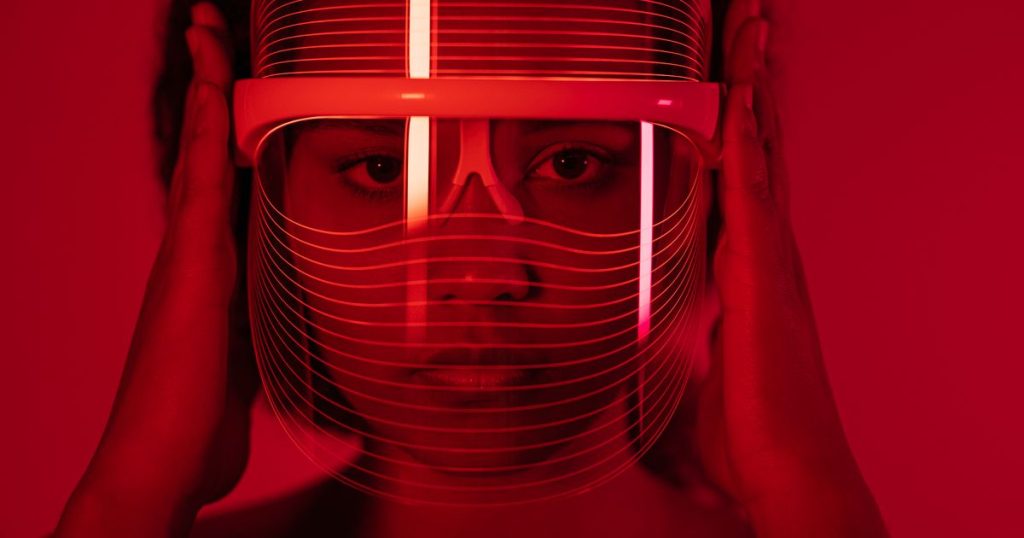The Rise of Red Light Therapy on SkinTok: What You Need to Know
The Glow of Red Light Therapy: A Trend Taking SkinTok by Storm
If you’ve spent any time on SkinTok recently, you’ve probably come across beauty influencers raving about the magical benefits of red light therapy. From glowing complexion testimonials to before-and-after photos, users claim this non-invasive treatment is the secret to achieving firmer skin, reducing wrinkles, healing acne faster, and even minimizing scarring. The trend has exploded, with a variety of devices flooding the market—ranging from affordable face masks and spot-treatment wands to high-end panels and even full-body sleeping bags that target everything from head to toe. Prices vary wildly, from a few hundred to several thousand dollars, catering to every imaginable skin concern. But the real question looms: Do these devices actually work, or are they just another overhyped, expensive gimmick in the ever-growing beauty industry?
The Science Behind Red Light Therapy: How Does It Work?
The concept of using light to improve skin health isn’t new. Dermatologists have long utilized phototherapy to treat conditions like eczema and psoriasis, leveraging specific wavelengths of light to target skin concerns. Red light, in particular, stands out because of its unique ability to penetrate deeper layers of the skin compared to other colors like blue or yellow light. According to Dr. Angela Casey, a board-certified dermatologist in Ohio, red light reaches the dermis—the layer of skin where collagen and elastic tissues reside.
When skin cells absorb red light, their mitochondria may boost energy production, enhancing cellular function. This increased energy is theorized to improve blood flow, stimulate stem cell activity, and promote the skin’s natural repair processes. Casey also notes that red light may reduce fine lines and wrinkles by stimulating collagen production while inhibiting enzymes that break it down. While these benefits sound groundbreaking, it’s important to approach the trend with caution. Much of the current understanding of red light therapy is based on early studies and theories rather than definitive, large-scale research. As Casey herself admits, she hasn’t purchased a red light device for personal use, citing the lack of hard evidence to support consistent results.
What the Experts Say: Promising but Not Proven
While some studies on red light therapy show promise, dermatologists highlight significant limitations that prevent these findings from being conclusive. Dr. Sabrina Alessi Cesar, a board-certified dermatologist at Duke University, points out that most research lacks placebo-controlled, randomized studies—essential for establishing scientific validity. Additionally, many studies have small sample sizes, often with fewer than 100 participants, which makes it difficult to draw meaningful statistical conclusions.
Another critical issue is the lack of standardization in red light devices. Effective light therapy requires precise wavelength and intensity levels, but manufacturers vary widely in both, making it challenging for consumers to ensure they’re getting an effective dose. For example, two similarly sized red light panels from different brands can emit vastly different levels of energy, leaving shoppers confused about what to choose. To complicate matters further, some devices combine red light with infrared or near-infrared light, which can penetrate even deeper but may also pose risks, such as thermal burns, if not used correctly.
Can At-Home Red Light Devices Actually Change Your Skin?
Despite the buzz, experts remain skeptical about the ability of at-home red light devices to deliver the same results as professional treatments. While some studies suggest red light therapy can improve skin texture, reduce inflammation, and even accelerate wound healing, these findings are often based on animal studies or small-scale human trials. There’s no consistent evidence that at-home devices can produce the same effects, especially since many lack FDA clearance or rigorous testing.
From a cost-benefit perspective, dermatologists recommend prioritizing proven treatments like retinoids over splurging on a red light device. However, they don’t outright discourage trying one, as long as you approach with caution. If you’re considering red light therapy, look for FDA-cleared devices and follow the manufacturer’s instructions carefully. Overuse, especially with devices emitting infrared light, can lead to thermal burns or eye damage.
Safety First: Precautions to Consider
Before diving into red light therapy, there are several precautions to keep in mind. First and foremost, protect your eyes. Dr. Sruthi Arepalli, an assistant professor of ophthalmology at Emory University, emphasizes that eye structures are far more delicate than skin and can’t tolerate intense light exposure. Even though red light may not cause direct discomfort, prolonged or improper use could lead to corneal damage or retinal burns. Arepalli recommends choosing devices that can be placed close to the skin to minimize eye exposure and using infrared goggles if the device emits near-infrared light.
Another important consideration is your individual skin type and health. If you have photosensitive conditions like lupus or are taking medications that increase sensitivity to light, red light therapy may not be safe. Additionally, those with darker skin tones should exercise caution, as red light devices could potentially trigger hyperpigmentation or conditions like melasma, especially if they involve heat.
Finally, remember that the long-term effects of red light therapy are still unknown. While there’s no evidence linking it to skin cancer or cellular damage, experts like Casey note that consistent, long-term use hasn’t been studied thoroughly. This is partly because, until recently, red light therapy was primarily used in medical settings under professional supervision.
Weighing the Cost and Benefits: Is Red Light Therapy Worth It?
The decision to try red light therapy ultimately comes down to your personal priorities and budget. While the idea of a non-invasive, at-home solution for better skin is appealing, it’s crucial to temper expectations. Dermatologists agree that the current evidence, while intriguing, isn’t robust enough to guarantee results.
If you’re curious about red light therapy, consider starting with professional treatments in a dermatologist’s office or clinic, where the technology is more advanced and the results are better understood. For at-home devices, stick to reputable brands with FDA clearance, and always follow the instructions provided. Be wary of exaggerated claims or “miracle solutions,” as no single treatment can address every skin concern.
In the end, patience and persistence are key. Skin health is a journey, and while red light therapy might be a useful addition to your routine, it’s unlikely to be a magic bullet. Combine any new treatment with tried-and-true skincare staples like sunscreen, moisturizer, and retinoids, and consult with a dermatologist before making any major changes to your regimen. After all, glowing, healthy skin is a long-term commitment, not a quick fix.















